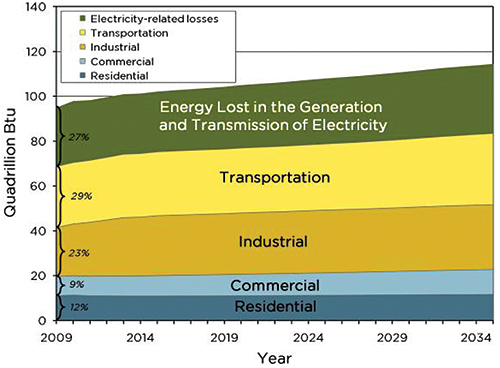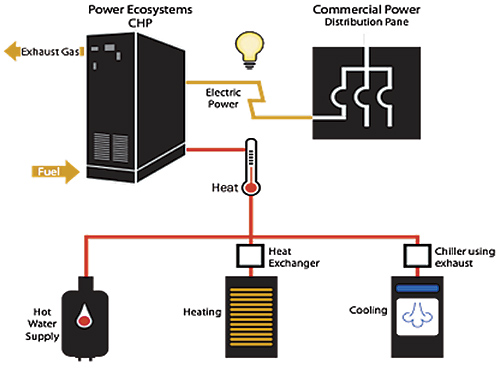Europe and Asia are well versed in the benefits of combined heat and power [CHP] or co-generation. This knowledge comes in companion with electrical costs of $0.25/ kWh and gasoline costs of $2.50 per litre along with multiples of two times or more for any comparable energy source in North America. The focus of this article is not renewable energy but it certainly has a significant green content and dependent on fuel it can be a very green solution. The generators will normally run on natural gas but options include propane, diesel, gasoline, oil and in some cases naturally occurring off gas/methane or bio-diesel. Some applications allow for multiple fuel options so that the generator can run on the most economic or available fuel at the time.
A commonly unknown fact and one that made it quite clear to me that distributed co-generation is only in its infancy in North America follows. The major use of energy on the planet earth is transportation, which includes all modes from trains, planes, ships, trucks, automobiles, and recreation vehicles. Not so hard to believe. The second expenditure of energy is wasted as heat in the generation of electrical power at large central power plants whether coal, nuclear or fossil fuels and in the losses related in transmission and distribution of the power to end users. This constitutes a full 27 percent of the annual global energy use or 30,000,0000,000,000,000 (quadrillion) BTU during 2014 in North America alone. Just for interest’s sake industrial energy use is a close third at 23 percent.

Figure 2. U.S. energy consumption by end-use sector projected though 2035. This is the EIA's reference
case projection from its Annual Energy Outlook 2011.12 Roughly 68% of the energy used to generate
electricity is unavailable due to generation and transmission losses.
So generating electrical power out in the “boonies” and transporting that energy after first transforming the voltage to higher transmission levels and then down again to distribution and again to utilization levels has its serious efficiency drawbacks. In addition to this the simple resistive (I2R) losses over long distances can be significant. The heat generated is usually pumped into lakes, often causing some potential aquatic issues or up the stack again creating other potential environmental concerns. Bottom line is that the heat energy is wasted. We are seeing more and more local distributed energy by utilities such as Enmax’s new downtown distributed energy center where hot water is used to heat nearby buildings. Reality is this is a drop in the bucket compared to overall electrical generation and consumption.
We need to get our heads out of the sand and start realizing the future is here now and planning infrastructure that makes sense for the next 20 to 25 years and beyond. Having a gas fired boiler sitting beside a conventional standby or peak shaving generator makes no sense. Sort of like running an electric heater in your car instead of gathering the engine heat. Amazing enough these projects typically pay for themselves in three to five years. In some specific cases the costs are recovered in less than two years. I cannot remember such a viable payback option since regulated electricity times when reduction of annual peak energy charges could be realized through power factor improvement or peak shaving technology.

In the de-regulated world we now find ourselves CHP would seem to be king. Not only does the owner get the benefit of reduced transmission and distribution costs but the essentially free heat energy can be used for other energy requirements such as domestic hot water, space heating or even chilling requirements through a heat exchange system. The CHP system is designed to be very efficient in recovering the maximum heat and includes the engine jacket as well as the exhaust to squeeze every bit of energy out of a highly efficient package.
Co-gen will work in any application where a base load of electrical power (kWh) exists and a relative sized thermal load exists (BTU). In some cases the thermal load is seasonal but in many cases an annual electrical and thermal load can be matched up for an extremely attractive application. In Europe and Asia there are thousands of installations running systems from our key manufacturing suppliers Ener.G and Yanmar including hotels, supermarkets, industrials, car washes and institutional facilities. A good example of a perfect match for co-gen is a hotel where the heat generated is used to keep the pool water, showers, laundry, space heating and the electricity for the guests power needs all simultaneously at the highest efficiency level available.
Sizing of generation is usually dependent on the facility base minimum electrical load. In some cases where thermal load is larger than the comparative generation output the additional power can be exported to the electrical utility. This requires some additional interconnect protection and control but this is normally possible without too much trouble in our new de-regulated energy environment. There are applications where the electrical and thermal energy can be shared among several related facilities using internal or utility conduits. An example as case in point is the new Enmax Boyle Renaissance Project in Edmonton. Even personal homes have gained the benefit of CHP technology. Co-gen can make sense from 5 kW to 100 MW size and beyond. The majority of corporately financed projects for medium size distributed power are in the 250 kW to 5 MW range.

Engineering and installation is pre-engineered, productized and made as simple and straightforward as possible. The units are supplied in an indoor or outdoor sound proofed enclosure. All requirements for controlling and protecting the generator is self-contained. This includes advanced diagnostics and remote control and alarms. The connections are:
- fuel for the engine [typically natural gas]
- exhaust to atmosphere
- heat transfer medium [typically cold water]
- heat transfer out [typically hot water or steam]
- electricity out [typically 600V / 3 Phase / 4 Wire]
- electrical instrumentation signals [PT & CT]
Installation times dependent on size and location can be as little as a few days. Work is usually performed turnkey by the generator supplier but in certain cases the roles are split between customer selected engineering firm and contractors.
Financing can be provided by external financial institutions the generator supplier or even on a lease basis. Typically the dynamics of the project cost and payback drive the customer to self-finance based on 3 to 5 year payback time and sometimes less.

Installed cost, all in, for systems larger than 150 kW is generally about $1800 to $2600/ kW. This of course varies on size and location, the larger the generator the lower the cost per kW installed. Co-gen units are designed (budgeted) for continuous operation with regular maintenance practice to last 20 years. Longer duration is certainly possible but typically maintenance and repairs will start to be onerous dependent on actual in situ operation. Maintenance can be performed by the owner but usually is performed under contract and extended warranty by their representative.
To this point the benefits of co-gen have been promoted based on economics and of course saving money. This is a driving force and is usually justification on its own. The reality is that several other collateral benefits are realized which in some cases carry enough merit regardless of financial benefits. Some of these additional benefits include:
- Standby power in the event of normal supply failure. The co-gen can power important loads in the event of storm, flood, infrastructure upset or other catastrophic event
- Dual use as critical load/emergency generator to meet with building code compliance. The co-gen can serve as a power supply for base building loads and if emergency power is required the generator will serve this function until the requirement is past
- Extra stability to the facility power system when utility connection is weak or prone to voltage fluctuations, the generator can also be used to correct power factor for additional savings if penalties for low power factor are realized. The generator can also reduce peak energy penalties or “peak shave” again if benefit is realized
- The positive environmental impact is large and can result in several recognized benefits such as reduction in transmission and distribution infrastructure [steel, aluminum, concrete and copper] as well as reduction in unsightly overhead lines. Reduced I2R losses due to in-situ generation, no wasted energy. For the commercial sector co-gen can provide one of the best returns for dollar on prestigious LEEDS points
As stated at the beginning of this article the benefits of co-gen have long been realized in Europe and elsewhere in the world where energy costs have already reached a tipping point and beyond. Our tipping point is here and the future will only provide more reason to get on board with CHP. As with any newer ideas there will be leaders and followers but inevitably co-generation will become more and more a part of our infrastructure.
This is a value investment with many additional benefits. The time for co-gen is now.
White House Issues Executive Order in Support of CHP
This morning, on August 30, 2012, President Obama signed an Executive Order calling for action in the deployment of 40 gigawatts of new, cost-effective industrial Combined Heat and Power (CHP) capacity in the US by 2020. For more details, we urge you to read the Executive Order.
http://www.smartgridnews.com/artman/publish/End_Use_Efficiency/Is-CHP-really-one-of-the-next-big-things-5080.html/?fpt
About the Authors
 Dan Cloutier is president of Power Ecosystems Inc. and has significant expertise in incubating high-growth technology-based companies. Dan’s first involvement with combined heat and power solutions was as a volunteer Board member of Cardel Place where Dan spearheaded pursuing the first Gold Leed designation in Alberta about a decade ago.
Dan Cloutier is president of Power Ecosystems Inc. and has significant expertise in incubating high-growth technology-based companies. Dan’s first involvement with combined heat and power solutions was as a volunteer Board member of Cardel Place where Dan spearheaded pursuing the first Gold Leed designation in Alberta about a decade ago.
Power Ecosystems exclusively distributes Ener.G and Yanmar cogeneration systems in Canada. Collectively, with these partners, the company has over 6,000 commercial building cogeneration installations throughout the world. Power Ecosystems has been installing these systems in Canada since 2006, we are the Canadian under 1MW market share leader with installations completed for the likes of Atco, Enmax, Melcor, the cities of Calgary, Edmonton, and Saskatoon as well as Oxford Developments.
 John Hodson is the founder of Magna IV Electrical Engineering Calgary and co-founder of Power System Asset Management Solutions and a shareholder of Power Ecosystems.
John Hodson is the founder of Magna IV Electrical Engineering Calgary and co-founder of Power System Asset Management Solutions and a shareholder of Power Ecosystems.







